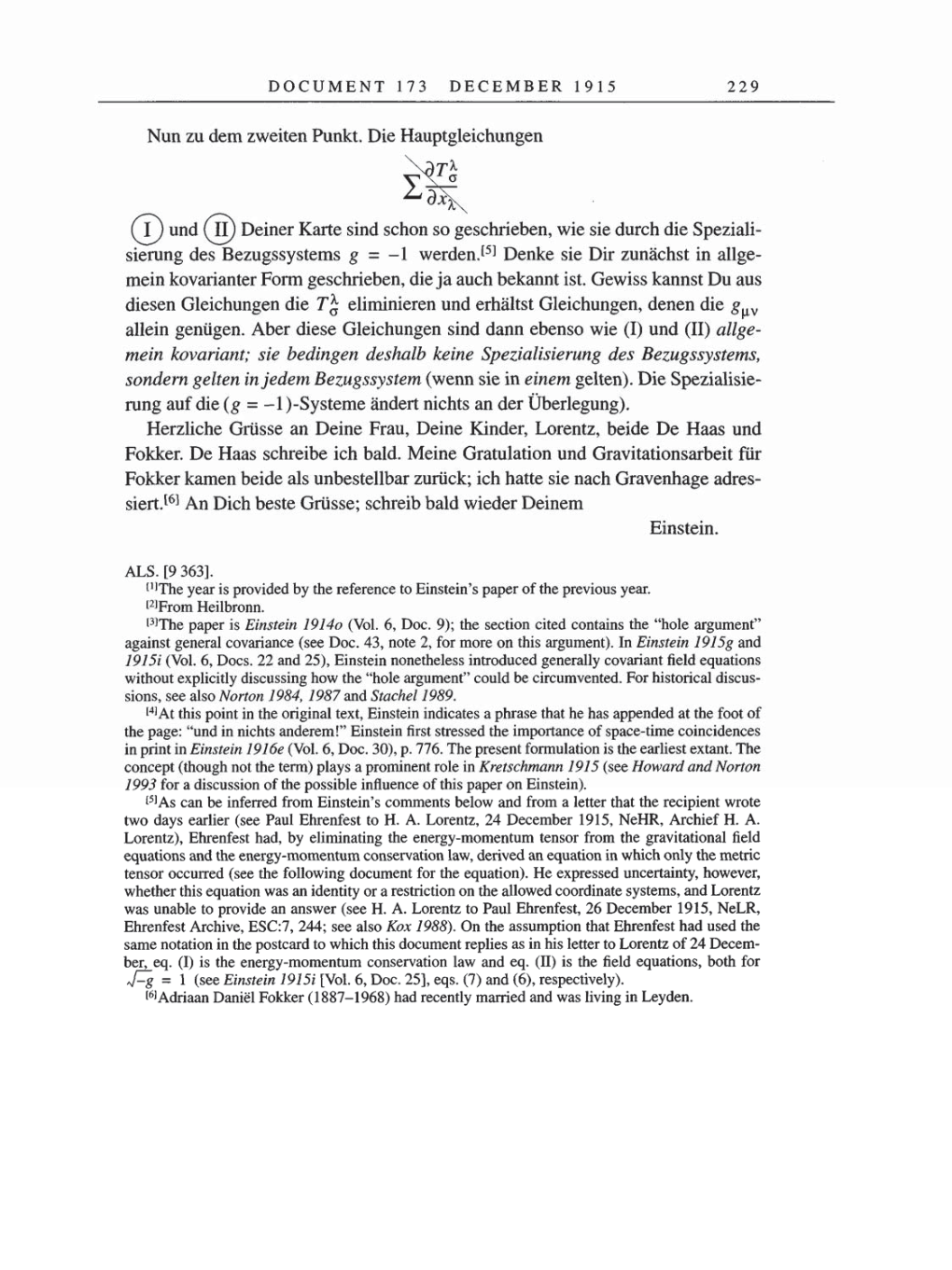DOCUMENT 173 DECEMBER 1915
229
Nun
zu
dem zweiten Punkt. Die
Hauptgleichungen
'
dx.
I
und
II
Deiner Karte sind schon
so
geschrieben,
wie sie durch die
Speziali-
sierung
des
Bezugssystems g
=
-1
werden.[5]
Denke sie Dir zunächst in
allge-
mein kovarianter
Form
geschrieben,
die
ja
auch
bekannt
ist. Gewiss
kannst
Du
aus
diesen
Gleichungen
die
Tyc
eliminieren und
erhältst
Gleichungen,
denen die
guv
allein
genügen.
Aber diese
Gleichungen
sind dann ebenso wie
(I)
und
(II) allge-
mein
kovariant;
sie
bedingen
deshalb
keine
Spezialisierung
des
Bezugssystems,
sondern
gelten
in
jedem Bezugssystem (wenn
sie
in
einem
gelten).
Die
Spezialisie-
rung
auf
die
(g
=
-1
)-Systeme
ändert nichts
an
der
Überlegung).
Herzliche Grüsse
an
Deine
Frau,
Deine
Kinder, Lorentz,
beide De Haas
und
Fokker. De Haas schreibe ich bald. Meine Gratulation und Gravitationsarbeit für
Fokker kamen
beide
als
unbestellbar
zurück;
ich hatte sie nach
Gravenhage
adres-
siert.[6]
An Dich beste
Grüsse;
schreib
bald wieder
Deinem
Einstein.
ALS.
[9 363].
[1]The
year
is
provided by
the reference to Einstein’s
paper
of
the
previous year.
[2]From
Heilbronn.
[3]The paper
is Einstein
1914o
(Vol.
6,
Doc.
9);
the
section
cited contains the “hole
argument”
against general
covariance
(see
Doc.
43,
note
2,
for
more on
this
argument).
In Einstein
1915g
and
1915i
(Vol. 6,
Docs. 22 and
25),
Einstein nonetheless
introduced
generally
covariant field
equations
without
explicitly discussing
how the “hole
argument”
could be circumvented. For
historical
discus-
sions,
see
also Norton
1984,
1987
and Stachel 1989.
[4]At
this
point
in the
original
text,
Einstein indicates
a
phrase
that he has
appended
at the foot
of
the
page:
“und in nichts anderem!” Einstein first stressed the
importance
of
space-time
coincidences
in
in Einstein 1916e
(Vol. 6,
Doc.
30),
p.
776. The
present
formulation is the earliest extant. The
concept
(though
not the
term)
plays a prominent
role in Kretschmann 1915
(see
Howard and
Norton
1993 for
a
discussion
of
the
possible
influence
of
this
paper on
Einstein).
[5]As
can
be inferred from Einstein’s comments below and from
a
letter that the
recipient
wrote
two
days
earlier
(see
Paul
Ehrenfest
to
H. A.
Lorentz,
24
December
1915, NeHR,
Archief
H. A.
Lorentz),
Ehrenfest had,
by eliminating
the
energy-momentum
tensor
from the
gravitational
field
equations
and the
energy-momentum
conservation
law,
derived
an equation
in which
only
the
metric
tensor occurred
(see
the
following
document
for the
equation).
He
expressed uncertainty,
however,
whether
this
equation was
an
identity or a
restriction
on
the allowed
coordinate
systems,
and Lorentz
was
unable to
provide
an
answer
(see
H.
A. Lorentz
to Paul Ehrenfest,
26 December
1915, NeLR,
Ehrenfest
Archive, ESC:7, 244;
see
also
Kox 1988).
On the
assumption
that Ehrenfest
had
used the
same
notation in the
postcard
to
which this document
replies as
in
his letter to Lorentz
of
24 Decem-
ber,
eq.
(I)
is the
energy-momentum
conservation law and
eq. (II)
is the field
equations,
both
for
J-g
= 1
(see Einstein 1915i
[Vol. 6,
Doc.
25], eqs. (7)
and
(6), respectively).
[6]Adriaan Daniël Fokker (1887-1968) had
recently
married
and
was living
in
Leyden.
